Mary Pearl is the president of Wildlife Trust, cofounder of its Consortium for Conservation Medicine, and an adjunct research scientist at Columbia University. Wildlife Trust is a global organization dedicated to promoting innovative conservation science, linking ecology and health, and empowering lasting local conservation.

Monday, 9 Jun 2003
PALISADES, N.Y.
I never have typical weeks, and this is no exception. Will the sum of this week’s activities create a distorted view of Wildlife Trust? When I’m based at our home offices in New York, weeks do have one commonality — they are all frantically busy and fragmented. So by the time we get to Friday, you should know the range of Wildlife Trust’s work.
Being the president of a conservation organization calls on a variety of skills, among them envisioning program directions, advising staff scientists and administrators, motivating and responding to the volunteer board of directors, and searching, constantly, for funds to underwrite our programs. And that’s just looking inward. The reason we are in business, of course, is to advance our mission outward: to create a healthy world for people and nature by linking ecology and health through innovative science, guiding policy, and strengthening the abilities of local conservation leaders and their organizations on the ground, around the world. We have an expression at work — “let’s take it down to the ground” — and by that we mean that our priority is to maintain our connection to that mission in everything we do. It is easy for a growing organization to get caught up in distracting competitions or bureaucratic entanglements, and at Wildlife Trust, we want to maintain our focus on what is important and what brings us to careers in environmental conservation in the first place. Therefore, each day I try to make sure I have advanced our mission in some specific, tangible way.
Over the weekend, the Centers for Disease Control announced a U.S. outbreak of monkeypox, a rare virus related to smallpox that usually occurs only in rainforests in central and western Africa. Squirrels and rodents are the reservoirs for monkeypox virus, which from time to time affects people (and of course monkeys, where it was first described). It seems that people in the pet trade in Wisconsin imported a rainforest rat from Gambia, which turned out to be carrying the virus, and the unfortunate rat passed the disease to prairie dogs for sale. Worse, the sick animals were taken to a “pet swap” in Wisconsin, also attended by people from Illinois and Indiana. The result? A number of people who handled sick animals have contracted the disease, which is serious enough to kill up to 10 percent of the people who get it. In Africa, the virus doesn’t last very long within just human populations; people need to be re-infected from the reservoir of virus-carrying squirrels and rodents. The virus can be grateful that the pet traders so usefully seem to have provided a wild reservoir, the prairie dog, so that we can be assured that monkeypox may not just be a one-time guest, but instead may well be here to stay.
This morning, I read as much as I can find about the monkeypox, a member of the family of orthopox viruses, and think about how Wildlife Trust might respond to the issue. Emerging wildlife disease is a key area of work for our organization, and we have a team of wildlife veterinarians, epidemiologists, pathologists, and parasitologists who are already working on aspects of West Nile virus, fibropapilloma virus, and Nipah virus, all pathogens that have recently burst into human awareness. It is not your imagination: new and re-emerging diseases are occurring with increased frequency, and a good deal of them come from wildlife. What the news stories do not tell you is that these disease outbreaks are predictable and therefore somewhat preventable, if we systematically address the pathogen pollution that can occur in live animal markets, the exotic pet trade, unmonitored travel from outbreak areas, and intensified livestock operations that reduce animal immunity to wildlife disease. Our land-use choices also affect disease: We need to recognize that when humans carve up and then move into wildlife habitat, we force infectious agents to adapt to the new environmental conditions we have created. This often includes our own bodies as new hosts for old wildlife viruses.

Dami Buchori in the field with Javanese farmers. Fred Koontz, Wildlife Trust’s executive vice president, is at left.
Photo: Wildlife Trust.
My husband, Don, left on Saturday for meetings in Ecuador as chair of a task force on environmental sustainability for the Millennium Goals project of the United Nations. I’m working on a paper commissioned by the task force to list education and training programs in environmental sustainability around the world. My co-lead author, Indonesia-based Wildlife Trust Program Leader Damayanti (“Dami”) Buchori, and I have assembled over a dozen coauthors from nations in every corner of the world to help us analyze how a young person growing up anywhere — from Paraguay to Pohnpei — might access the tools to become a professional steward of the environment. The bottom line: Training needs do not match training opportunities. Training is easiest to find where the biodiversity isn’t, and the biodiversity is highest where opportunities and resources are scarce. Dami is going to the meeting to present our preliminary results. She has extensive experience with this problem in Indonesia.
As an Indonesian environmental scientist with advanced degrees from the U.S., Dami is a very rare resource, and is often overwhelmed with the demands on and need for her time, whether it is from a local professional colleague who needs her help to write a grant proposal in a format attractive to funders in the West, or from farmers who have come to rely on her research on reducing insect pests (without dangerous, expensive pesticides) through better management of native, natural insect predators. Dami’s innovative science merits international notice, and she, like so many other developing-nation scientists, should have more colleagues and more resources with which to build training programs similar to the ones she attended in the U.S. We both hope that the paper we are working on will lead policy makers to address this imbalance.

Juggling career and parenting.
Photo: Wildlife Trust.
I am not going to these meetings, and will instead keep working on drafts of the paper from here in New York. Don and I have another important collaboration — our two children, ages 15 and 20. Today is our son’s first day working as a volunteer at our local zoo. I’ll take him there on my way to work this morning. It seems our daughter, now studying in Brazil, has picked up our wanderlust, and our son has inherited our love of animals. Don and I juggle our schedules so that one of us is always at home: He will return on June 21, when I begin a two-week trip to Tanzania. That reminds me: This afternoon, I’m scheduled for typhoid and hepatitis immunizations. I’m going to Tanzania for two reasons: to meet with Patricia Moehlman, a Wildlife Trust program leader based in Arusha who is training a number of conservation professionals in Ethiopia, Eritrea, and Tanzania; and to motivate prospective and current Wildlife Trust members by experiencing with them, in the field, the phenomenal east African savanna wildlife.
Tuesday, 10 Jun 2003
PALISADES, N.Y.
Yesterday was consumed with responding to press inquiries about the monkeypox virus and the dangers of getting sick from viruses in imported exotic animals in the pet trade. It is likely that, in addition to the monkeypox hitchhiking to Wisconsin on a giant Gambian pouched rat, West Nile virus traveled to the U.S. in a mosquito or bird in the pet trade. Global travelers — both wildlife and human — are increasing in numbers and bringing diseases to naive communities (ones that have not been exposed to a pathogen), and we have to pay attention to this trend.
Late in the afternoon I had to go into a radio studio to do an interview for NPR, so I missed my inoculations for Africa and will have to reschedule them. This morning in the elevator of my apartment building, a neighbor asked if mice might carry monkeypox. It is not out of the question, I told her, in that a prairie dog shedding the virus could conceivably pass it along. A colleague sends me an email this morning noting that some well-meaning people have been clandestinely reintroducing pet prairie dogs into former wild prairie dog habitat in the western U.S. Unmonitored reintroductions of monkeypox-infected prairie dogs would be a very efficient way to establish monkeypox in squirrel and rodent populations sharing the habitat. Not a great thought to start the day …
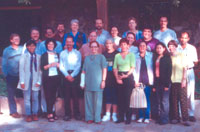
Some Wildlife Trust Alliance members.
Photo: Wildlife Trust.
But I’m really excited today because Claudio Valladares Padua comes in from Brazil for several days of meetings. Around 10:30, Claudio arrives from the airport, and we begin to discuss our plans for the upcoming year (our year runs from July 1 to June 30). Claudio is coordinator of the Wildlife Trust Alliance, which is a fantastic network of some of the most talented and committed conservation scientists you’ll find in the world today. Claudio and I share a vision in which the ideas and innovations of the best local practitioners of conservation science find an audience and replication throughout the world. To work toward that vision, Wildlife Trust helps develop and find support for research projects, and we identify and work individually with conservationists with outstanding potential. We work as career consultants, scientific advisors, mentors, brokers, and megaphones, to create an international voice for conservation and a network for mutual support, advice, and guidance. Claudio, from his base in Brazil, provides leadership for this effort.
Claudio and his wife Suzana were recognized in a special issue of Time magazine last year for their imaginative and sensitive work that brought the newly settled landless people in western Sao Paulo State into a community of environmental stewards. Instead of viewing local poor people as obstacles to conservation, at Wildlife Trust we see them as potential allies. Suzana and Claudio were able to build a program that involves the rural community as joint stewards of the mosaic of agricultural lands and wildlife habitat. Local peasants have helped build corridors, wildlife “stepping stones,” and buffer zones, all of which benefit people and wildlife, such as jaguars, tapirs, and black lion tamarin monkeys, for their mutual survival in the Pontal region of Sao Paulo State.
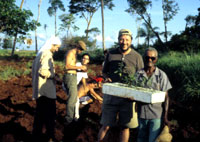
Claudio planting a wildlife corridor together with local community members.
Photo: Wildlife Trust.
You would think that most people would understand that local scientist-conservationists are the people in the best position to achieve lasting environmental conservation. Yet that is not true: The notion that people in developing countries have to be “saved” by foreigners from America and Europe is a persistent myth. In fact, I tell Claudio about an exchange of emails I had last week with a TV producer. With all the nature programming on television, we get a lot of requests for access to our wildlife projects. The producer informed me that he was filming a new series about “heroes” (is anyone else getting tired of this word?) of the environment, and he wondered if we had projects led by Americans or Britons in remote places. I responded that Wildlife Trust projects are mostly run by local scientists heroically dedicated to protecting and creating healthy ecosystems where they live. He told me that filming local people would not be as good a television story. He had one episode planned where the British woman in charge of a project says that she wants to make herself redundant one day. Didn’t we have some similar project with an American leader with some very good local assistants who could be praised? I told him (diplomacy is not my strong suit) that it would be a betrayal of the leadership and acumen of our field scientists around the world to give the erroneous impression that Wildlife Trust relies on Americans and Britons going into foreign countries. I also opined that it would be nice if, in the course of his career, he could find a way to influence American audiences to develop a more internationalist and respectful attitude toward the leading thinkers of other countries.
Claudio and I discuss the status of a joint paper the Alliance is producing on “Managing Endangered Species in Human-Dominated Landscapes,” and we go over the roster of projects, noting which ones he or I will visit during the course of the year. We also prepare for an important set of meetings tomorrow, with a potential funder and with the newest member of the Wildlife Trust Alliance.
Wednesday, 11 Jun 2003
PALISADES, N.Y.
Coming on the heels of the SARS scare, the current fear about the new monkeypox virus that spread from Africa to the U.S. Midwest via imported Gambian giant rats has led more and more journalists to the understanding that something systemic is going on. At last, the scientists at Wildlife Trust have opportunities to help the general public understand the connections between environmental disturbance, global travel, and the spread of disease.
Fear may be the motivator, but still, this is an opportunity to inform people about how we can start to make healthy decisions about our land use and consumption patterns. At last, we can make the case that wildlife and habitat conservation are not esoteric pleasures for the well-to-do, but instead the actual underpinning of human well-being everywhere. Members of our staff are being lined up for radio and television interviews. I am told that a film crew will arrive on Thursday or Friday to interview me about wildlife and human disease links. The challenge will be to ensure that people understand that biodiversity, i.e. lots of species, is actually a buffer against disease. We cannot demonize wildlife; it is human disturbance that forces disease-causing agents to leave their reservoir species and jump to us and our domesticated animals.
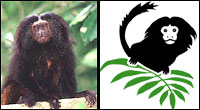
A real black lion tamarin and the Wildlife Trust logo.
Photo: IPE Brazil.
After dropping my son Seth off at the zoo, and before joining Claudio Valladares Padua, our visitor from Brazil, I have a meeting with the Positioning Task Force of the Wildlife Trust board of directors. It is a small but exciting group of professionals: a designer, a marketing executive, and a wildlife exhibit designer. Among us, we have identified a key problem facing our organization: visibility. Wildlife Trust has a truly unique niche in the conservation world, with our innovative science (for example, we were central in creating the new field of conservation medicine, which links ecosystem health to wildlife, livestock, and human health) and our fabulous field-based leadership through the Wildlife Trust Alliance (see yesterday’s diary entry). Yet our name and tagline (“Saving Nature Together”) do not differentiate us from the pack of conservation organizations.
What to do? We take a look at our official mission statement: “Wildlife Trust conserves threatened wild species and their habitats in partnership with local scientists and educators around the world.” Where is the innovation? The cutting-edge science? The conservation medicine? Our flexibility, our responsiveness? At least we have one of the best logos in the business — symbolic of the very real recovery of Brazil’s black lion tamarin from near extinction.
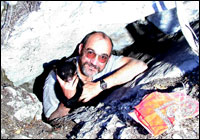
Rodrigo and a little ursine companion in Mexico.
Photo: Rodrigo Mendellin.
After the task force meeting, Claudio and I discuss plans for a pre-congress workshop he is organizing for young primate biologists before the next meeting of the International Primatological Society. We then race off to meet Rodrigo Medellin for lunch. Rodrigo is a prominent ecologist and internationally recognized mammologist visiting New York on sabbatical at Columbia University. He is the leading scientist at the Institute of Ecology of the National University of Mexico. We discuss the possibility of him and his team joining the Wildlife Trust Alliance. He is not only a superior bat ecologist; he also has a flair for public education. I also admire how he designs his conservation programs so that he can measure his effectiveness with great precision. He has documented how he combines applied research, policy recommendations, and public education to achieve tangible results in terms of restoration of populations of endangered species. His work and his generous interest in building careers of Latin American colleagues are real winners. We discuss ideas for his future collaborations with the alliance.
There is not enough time; suddenly it is 2:30 and we have to rush off to meet the head of a new foundation that has been created to help the people of Brazil by tapping into the interest and wealth of the growing Brazilian-American community in New York. Claudio and I hope that we can enlist the support of this foundation for our brand of community-based, science-based wildlife conservation.
Thursday, 12 Jun 2003
PALISADES, N.Y.
Yesterday afternoon, the booking producer from a news show lined me up for an interview at my office this morning, to discuss diseases that wildlife give to humans and vice versa. I sent her some articles I’ve written to give her an idea of the work I’ve done in the field of conservation medicine.
By the time you are interviewed for a news show as the “expert,” you’re really kind of a prop, because the writers have already worked out what points they want to see raised (based on your earlier conversations, you hope), and you only have a chance to utter very brief sound bites in response to a few questions. You just pray that the interviewers don’t surprise you with a question from out of left field that leaves you looking a little less than authoritative, and that they give you a chance to express an idea that will leave the audience thinking about the importance of environmental conservation and their personal role in protecting ecosystems. You also hope that you did not have spinach in your teeth.
Usually, with a taped interview, they boil down 15 or 20 minutes to as little as two to four, so you stew until the program is aired, not knowing what will be emphasized. The program I was interviewed for this morning will be on the air Monday evening, so I’ll try to put the whole thing out of my mind over the weekend.
The second Thursday of every month, we have a meeting of the full staff of Wildlife Trust, which means that the employees from our Philadelphia and Sarasota offices join the New York staff. The meeting is typically part information-sharing, part strategizing, part socializing, and part celebrating. As soon as the TV crew leaves, we meet.
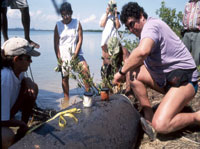
Alonso Aguirre inspects the health of a manatee.
Since it is the last full staff meeting of the fiscal year, we will celebrate the fact that we have never accomplished more on the ground, around the world than we did over the past 12 months. Happily, even in this continuing economic downturn, we were able to garner more support from foundations and government agencies than ever before, and our program grew. Helped no doubt in part by public fears about the West Nile virus and SARS, there was finally recognition from funders that our work studying wildlife disease as a threat to various endangered species is also important to people.
We have created a system of animal sentinels of pathogen pollution, and these pathogens can affect people as well as plants and animals. Our book, Conservation Medicine was published under the lead editorship of our director for conservation medicine, Alonso Aguirre. This book represents a first effort at defining this critically important new academic discipline and health practice.
Our Wildlife Trust Alliance has grown as more and more top scientists and conservationists seek to join us. The biggest leap for us this past year, however, has been in the size and reach of our national program. Wildlife Trust has built major programs in the New York area, which I will mention tomorrow, and in the southeastern U.S., where we conducted studies on the health and whereabouts of marine mammals.

North Atlantic right whale.
Photo: NOAA.
There was also cause for sadness this year. On Super Bowl Sunday, when most people were planning parties, four members of our whale watching team died when their plane crashed while they were identifying the locations of North Atlantic right whales off the coast of northern Florida. Our small, close-knit organization was devastated by this loss. Together with the friends and families of our lost colleagues, Wildlife Trust created a memorial, a fund that will be spent annually on projects to carry on their work to protect marine life around the world. During our meeting, we have a moment of silence to remember Emily, Jackie, Michael, and Tom.
Our meeting ends with a celebration of Victoria Soto’s impending marriage and enrollment for a doctorate in botany at the University of Georgia. We welcome Victoria’s replacement as conservation medicine program assistant, and also welcome our newest interns.
After the meeting, Claudio and I head back into the city to meet with Daniel Katz, the program officer of the Overbrook Foundation. Overbrook awarded a grant to Wildlife Trust and an Ecuador-based organization, Futuro LatinoAmericano, to develop skills in resource conflict negotiation for people involved in seemingly intractable conflicts over land use in Brazil, over the illegal pet trade in Mexico, and over petroleum extraction in Ecuador. Claudio hosted an organizing and skill-building meeting for teams of conflict arbitrators from each country, and is now following up with each team, to learn if the negotiation skills have had an impact on resolving resource conflict issues. We meet with Daniel to update him on progress of the joint project.
Tomorrow will be another full day, so I prepare for an early-morning meeting with board members on the status of our strategic planning process, and for an afternoon public lecture on conservation medicine in the New York Bioscape. What is a bioscape, you ask? I’ll explain tomorrow.
Friday, 13 Jun 2003
PALISADES, N.Y.
First thing this morning, I met with board members via telephone conference to check in about all the task forces engaged in strategic planning for Wildlife Trust. We have created task forces to address critical issues for our next five years in a wide range of areas: operations, the international alliance of conservation scientists, positioning and marketing, development, and creating a business plan. It is my job to help the board members stay on track as they address issues that are important to staff, and to make sure that staff members remain engaged in framing the issues and working out methods to advance the organization along the strategic priorities established by the board.
If that sounds a little circular, it’s because a circle of communication and feedback is the key to how a successful nonprofit functions. Since Claudio will be returning to Brazil over the weekend, I invited him to talk to the board about his views on the direction of Wildlife Trust over the next five years. One critical question we addressed was the “macro objective” of Wildlife Trust: What is our envisioned completion point? One wish I would have for Wildlife Trust would be for us to become, and be recognized as, the best organization for producing and putting into practice innovations in conservation science at model sites in the U.S. and around the world. The challenge is to design a clear and measurable pathway so that we can all recognize and agree when we have succeeded in reaching that goal.
Next on the day’s agenda was a meeting with a Washington, D.C.-based board member, Philip Bermingham, who is visiting New York. He is new to the board and brimming with ideas on how we can attract more members and donors, based on his extensive experience as a member of the boards of several arts organizations. His enthusiasm is welcome and very encouraging in this gloomy economic climate.
Then I drop by the headquarters of the Center for Environmental Research and Conservation at Columbia University. CERC is a consortium of five institutions, including Wildlife Trust. Our official link to this top university enables our professional staff to advise students, interact with colleagues there, and in general stay sharp. I stop by to handle some administrative issues.
By the time I’m done there it’s noon, and I have to set off for Connecticut to give a speech to the members of Chester West, a seniors’ residence in Connecticut. Several weeks ago, I chose as the title for my speech, “Taking responsibility for disease emergence: the links between SARS, Lyme Disease, and West Nile encephalitis.” As I drove up I-95 from New York to Connecticut, I thought through my remarks.
I know from past lectures that people will be genuinely surprised to learn that their land-use choices can promote diseases. Much as the SARS virus jumped from wildlife to humans in a crowded landscape in southern China, Lyme disease became an epidemic when New York suburbs fragmented habitat and artificially elevated populations of white-footed mice and deer, the chief carriers of the Lyme spirochete that ticks bring to people when they bite them.
My goal will be to use the movement of pathogens like the Lyme spirochete to introduce the audience to the concept of the greater metropolitan region as a natural area, as opposed to one based on politics or culture, which is typically how people in our region view where they live. If one doesn’t see where one lives as a natural area, it is easy to ignore the fact that all our lives are bound together in a common set of watersheds and landscapes. If one feels no such connection, there can be no sense of common responsibility for clean air, water, and lands. At Wildlife Trust we call an area like this a bioscape — a human/natural landscape mosaic whose geographic area is defined by a common sphere of human influence.
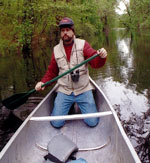
Fred Koontz paddling in the New York bioscape.
Photo: Wildlife Trust.
Fred Koontz, who came up with the concept of the bioscape, is also the director of our work here, in which we integrate science and ecosystem management with other human activities that affect the landscape. Our task is to form multidisciplinary teams to solve complex environmental problems and create a regional “sense of place” among local citizens. More than anything else, our research on the interactions between wildlife, human, and ecosystem health enlightens people to our common future and responsibility.
The talk is well received, and I am escorted to a reception to chat with this wonderfully enthusiastic group of elders. I am touched and inspired by their engagement and concern for the future of their children and grandchildren, and I hope that in turn, I have inspired some of them to become members of Wildlife Trust.
I also hope that in sharing the last five days with me, you have also become interested in the mission of our organization. I invite you to come visit us at our website, and become involved.

